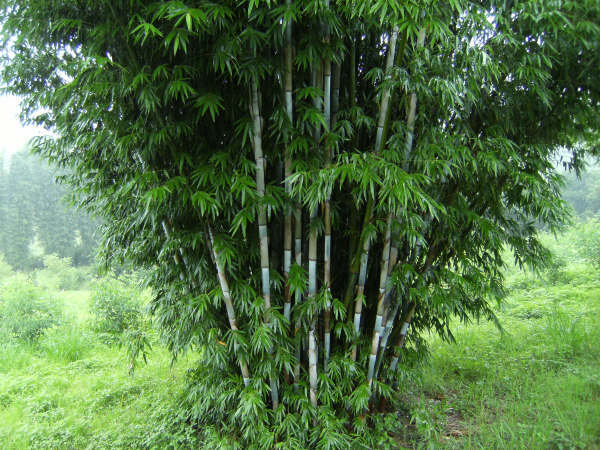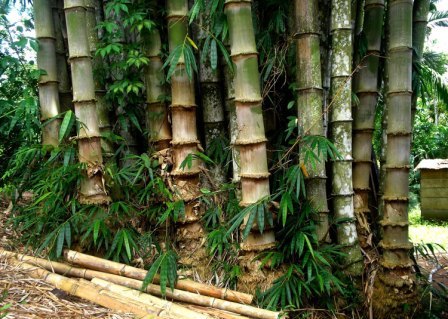



Giant bamboo is an evergreen, clumping bamboo with a short, thick rhizome and densely tufted, erect stems that can be 15 - 30 metres tall. The stems can be 8 - 20cm in diameter, producing aerial roots from the nodes and with internodes 40 - 50cm long.
Natural Regeneration Propagated by seed. Artificial Regeneration Propagated by plant stock, branch cuttings or culm cuttings. Seed collection Storage More than 100 years. Most planting material available in India are tissue culture plantlets derived from seeds of a flowering event about 25 years back and therefore for the next 75 years plantations are not expected to flower. Pretreatment The seeds should be soaked in cold water for 24 hours. Nursery Technique Seeds have short viability and should be sown within 2 - 3 months of harvest. Seeds can be sown directly on nursery beds in patches and cover lightly with soil. If fresh seeds are sown 90 to 100 percent germination can be achieved. Germination usually takes place readily. Partial shade is necessary for initial establishment of seedlings. The seedlings can be poly-potted after 45 days. Prick out into individual pots as soon as the plants are large enough to handle. Plant out into permanent positions when 20cm tall. Plants may remain in their low-growing juvenile state for several years - cutting the culms to the ground level can stimulate tall growth. Large scale production can be achieved through macro proliferation. Offset planting: It can be done during the onset of monsoon but this method is expensive for transportation and rhizome extraction as it is difficult. This species is also propagated through culm cutting and branch cuttings after treated with growth regulating hormone.
Season of planting Planting during the pre monsoon showers or prior to active monsoon.Pre planting operations- Demarcation / fencing to be completed at least three months prior to planting. Weeding, at least 15 days prior to planting. Pit size & treatment 45 X 45 X 45 cm cubical pits, to be half filled and kept exposed to sun for top soil sterilization for about a month. Planting Along with the pre monsoon showers/prior to active monsoon the pits are completely filled and planted with one year old planting stock. The filled up soil to be compacted around the plant. Spacing Closer spacing of 4 X 4 m for edible shoot production, 5 X 5m when planted as a species in ornamental/shelter belt plantations and 7 X 7 m for timber production.
Irrigation Responds well to irrigation however essential only during the first two years to ensure better establishment andquicker culm production. If grown for edible shoots watering ensures enhanced sprout production. Moisture retention through trenches should also be practiced. Thinning Regular thinning and cleaning should be carried out from the 4th year of clump establishment. All dry, dead and drying culms are to be removed from the clump so as to create sufficient space in the clump for new sprouts to grow up straight. As a regular practice these operations are to be carried out every year probably prior to the winter months. Cultural practices All dead and dying culms to be cut and removed from the third year of establishment. Thorns to be pruned from the base of the clump every year preferably in the months of November –December. Rot of culms The infection causes rot of the tender, succulent emerging shoot, which becomes discoloured, and gives off a strong smell of molasses. The disease control can be achieved by taking preventive measures (spraying insecticide, Monocrotophos 0.05 % a.i.) against build-up of Purohita cervina population during the culm elongation phase and by application of fungicide Carbendazim (Bavistin) or Mancozeb (Dithane M 45) at 0.2 % a.i. on the infected culms. Bamboo blight Application of Carbendazim (Bavistin) combined with Mancozeb.
Harvesting may start 3 - 4 years after a clump has begun to produce culms of maximum size. Only culms older than 3 years are harvestable and harvesting should never be done during the growing season. It is recommended to cut the culms lower than 30cm above the ground level, but not below the 2nd node.
Yields of 10 - 11 tonnes per hectare of bamboo shoots is possible.
Wood The culms have thick walls and are very strong and durable. They are used as building material for houses and bridges, for making furniture, boards, musical instruments, household utensils, crafts, outriggers of fishing boats and for paper making. The internode is opened at one end (or the node) and filled with vegetables, meat or rice, and water, and is then covered and placed on a fire.
They are often cooked in two changes of water to remove the bitterness. The young shoots are harvested as they emerge from the soil.The sugary sap is made into a drink in North East India.